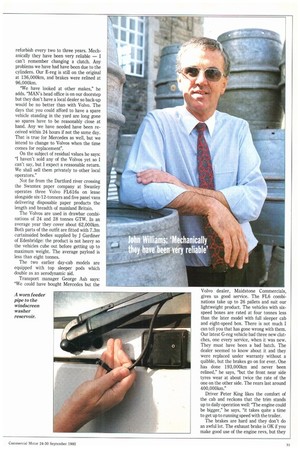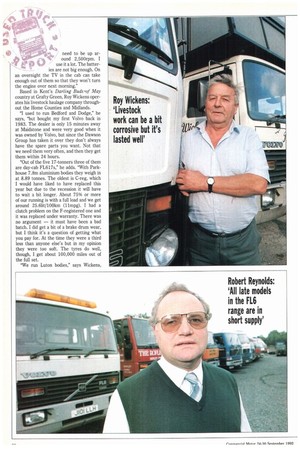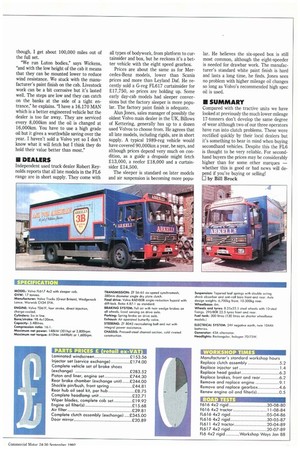li ELIA BLE • Over the past 12 months we've taken a
Page 30

Page 32

Page 33

Page 34

Page 35

If you've noticed an error in this article please click here to report it so we can fix it.
hard look at how some of the most popular 38-tonners on the road satisfy those who operate and sell them. Now it's the turn of two-axled rigids up to 17 tonnes, and we open our account with the Volvo FL6 range. It's all of 25 years since the first Volvo tractive units became available in the UK, but we had to wait until October 1979 before the company extended its range down to 16.26 tonnes with the two-axled rigid F6. Its premium specification included the "Club of four" cab, shared by Renault, Magirus and Daf, a turbocharged six-cylinder 132kW (178hp) TD6OB 5.48-litre diesel and a sixspeed ZF gearbox. But its £16,550 price tag was almost £3,000 higher than other 16-tonners of the day. It was also one of the lightest around, with a kerbweight of 4,705kg on the shortest 3.5m wheelbase.
Six years later Volvo launched the FL rigid rated at 12 and 14 tonnes in addition to the top-weight FL616. The low-mounted FL cab made access much easier for multidrop delivery drivers. By then the 5.48-litre Volvo engine had also been revised: the standard engine was the 154kW(207hp) charge-cooled TD61F which had plenty of muscle for drawbar work at 28 tonnes GTW, while the lower rated 134kW(180hp) wok. TD61GS became
the low-power option. Air suspension on the drive axle, with height adjustment over 230mtn, became an option to the standard parabolic springs, and air brakes were fitted as standard throughout the range. Like all Volvo cabs the FL's exposed steel panels are galvanised and it is built to meet tough Swedish safety standards.
• EVOLUTION
In May 1987 enter the new FL617 with the same 154/134kW power ratings but now for operation at the new 17-tonne weight limit and that autumn, in recognition of changes in the 4x2 rigid's operational pattern, the sleeper-cab's long-term continental availability was extended to UK models. Volvo's R1000 lightweight nine-speed aluminium gearbox superseded the range-change R52 box, for drawbar applications — the solo rigid stuck with the six-speed ZF transmission. For drawbar work the R1000's low (16.7:1) ratio maintained slow speed traction while allowing a fast drive axle ratio to be specified for vehicles tackling a large proportion of motorway work.
Last October a 7.5-tonne front axle brought the design weight up to 18 tonnes to give the improved load tolerance of the FL618. Environmental pressures also led to the adoption of the low-emission TD63ES at the slightly higher rating of 157kW(210hp) as an option. The long-serving TD61GS was dropped, leaving the 154kW TD61F as the standard power unit. Apart from being greener the TD63ES has 13% more torque on tap.
• OPERATORS
Swindon's local brewery, Arkells, will be 150 years old next year. In recent times it has increased its number of tied houses to about 80. Most of them are within 301un of the company's Kingsdown premises in the M4/M40 corridor, but the company also supplies free houses as far afield as London.
Transport manager John Williams is responsible for the fleet of five HGV drays used for pub and off-licence deliveries. Three are Volvo FL614 14-tonners; two are 13-tonne Mercedes-Benz.
"Before Mercedes and Volvos we ran Dodge trucks, but when the local dealer closed down we looked around for an alternative," says Williams. "We liked the Mercedes vehicles but the Volvos give us the opportunity to carry a little more payload when we need it. A normal load weighs around six to seven tonnes. We used to change them after five years but now we are looking for twice that. The Mercedes won't last quite that long but I expect the FL6s will.
"A local garage does all our servicing," he adds. "Our deliveries start out at 7am and finish when the job's done. That means most of our maintenance is carried out in the afternoon, so we don't have much nonproductive down time. A lot of our deliveries are very local so mileage is relatively low at a little over 20,000km a year. Fuel consumption is about 23.51it/100km (12mpg).
Williams originally specified 5.8m curtainsided bodies from Don Bur on 4.6m wheelbase 4x2 chassis. He found this very successful for multi-drop distribution, but on later vehicles he has switched to the slideaside design for the extra security if offers to a tempting cargo. The rigid sides also accept the plastic livery better; the curtainsiders had to be sign written.
"We always have a return load of empties so we don't experience the problem of axle loading sometimes experienced with a diminishing load," says Williams. "The FL cab is low mounted which makes it easy for the two-man crew to get in and out. One of the first things we noticed was the improved visibility at the kerbside. Our vehicles portray the company image so we refurbish every two to three years. Mechanically they have been very reliable — I can't remember changing a clutch. Any problems we have had have been due to the cylinders. Our E-reg is still on the original at 136,000km, and brakes were relined at 96,000km.
"We have looked at other makes," he adds. "MAN's head office is on our doorstep but they don't have a local dealer so back-up would be no better than with Volvo. The days that you could afford to have a spare vehicle standing in the yard are long gone so spares have to be reasonably close at hand. Any we have needed have been received within 24 hours if not the same day. That is true for Mercedes as well, but we intend to change to Volvos when the time comes for replacement".
On the subject of residual values he says: 'I haven't sold any of the Volvos yet so I can't say, but I expect a reasonable return. We shall sell them privately to other local operators."
Not far from the Dartford river crossing the Swantex paper company at Swanley operates three Volvo FL616s on lease alongside six-12-tonners and five panel vans delivering disposable paper products the length and breadth of mainland Britain.
The Volvos are used in drawbar combinations of 24 and 28 tonnes GTW. In an average year they cover about 62,000km. Both parts of the outfit are fitted with 7.3m curtainsided bodies supplied by J Gardiner of Edenbridge: the product is not heavy so the vehicles cube out before getting up to maximum weight. The average payload is less than eight tonnes.
The two earlier day-cab models are equipped with top sleeper pods which double as an aerodynamic aid.
Transport manager George Ash says: 'We could have bought Mercedes but the Volvo dealer, Maidstone Commercials, gives us good service. The FL6 combinations take up to 26 pallets and suit our lightweight product. The vehicles with sixspeed boxes are rated at four tonnes less than the later model with full sleeper cab and eight-speed box. There is not much I can tell you that has gone wrong with them. Our latest G-reg vehicle had three new clutches, one every service, when it was new. They must have been a bad batch. The dealer seemed to know about it and they were replaced under warranty without a quibble, but the brakes go on for ever. One has done 193,000km and never been relined," he says, "but the front near side tyres wear at about twice the rate of the one on the other side, The rears last around 400,000km."
Driver Peter King likes the comfort of the cab and reckons that the trim stands up to daily operation well: "The engine could be bigger," he says, "it takes quite a time to get up to running speed with the trailer.
The brakes are hard and they don't do an awful lot. The exhaust brake is OK if you make good use of the engine revs, but they need to be up around 2,500rpm. I use it a lot. The batter _ a ies are not big enough. On an overnight the TV in the cab can take enough out of them so that they won't turn the engine over next morning."
Based in Kent's Darling Buds .491 May country at Grafty Green, Roy Wickens operates his livestock haulage company throughout the Home Counties and Midlands.
"I used to run Bedford and Dodge," he says, "but bought my first Volvo back in 1983. The dealer is only 15 minutes away at Maidstone and were very good when it was owned by Volvo, but since the Dawson Group has taken it over they don't always have the spare parts you want. Not that we need them very often, and then they get them within 24 hours.
"Out of the five 17-tonners three of them are day-cab FL617s," he adds. "With Parkhouse 7.8m aluminium bodies they weigh in at 8.89 tonnes. The oldest is C-reg, which I would have liked to have replaced this year but due to the recession it will have to wait a bit longer. About 75% or more of our running is with a full load and we get around 25.61it/100km (11mpg). I had a clutch problem on the F-registered one and it was replaced under warranty. There was no argument — it must have been a bad batch. I did get a bit of a brake drum wear, but I think it's a question of getting what you pay for. At the time they were a third less than anyone else's but in my opinion they were too soft. The tyres do well, though, I get about 100,000 miles out of the full set.
"We run Luton bodies," says Wickens,
though, I get about 100,000 miles out of the full set.
"We run Luton bodies," says Wickens, "and with the low height of the cab it means that they can be mounted lower to reduce wind resistance. We stuck with the manufacturer's paint finish on the cab. Livestock work can be a bit corrosive but it's lasted well. The steps are low and they can catch on the banks at the side of a tight entrance," he explains. "I have a 16.170 MAN which is a better engineered vehicle but the dealer is too far away. They are serviced every 8,000km and the oil is changed at 16,000km. You have to use a high grade oil but it gives a worthwhile saving over the year. I haven't sold a Volvo yet so I don't know what it will fetch but I think they do hold their value better than most."
• DEALERS
Independent used truck dealer Robert Reynolds reports that all late models in the FL6 range are in short supply. They come with all types of bodywork, from platform to curtainsider and box, but he reckons it's a better vehicle with the eight speed gearbox.
Prices are about the same as for Mercedes-Benz models, lower than Scania prices and more than Leyland Daf. He recently sold a G-reg FL617 curtainsider for £17,750, so prices are holding up. Some early day-cab models had sleeper conversions but the factory sleeper is more popular. The factory paint finish is adequate.
Alun Jones, sales manager of possibly the oldest Volvo main dealer in the UK, Billows of Kettering, generally has up to a dozen used Volvos to choose from. He agrees that all late models, including rigids, are in short supply. A typical 1989-reg vehicle would have covered 90,000km a year, he says, and although prices depend very much on condition, as a guide a dropside might fetch £13,000, a reefer £18,000 and a curtainsider £14,500.
The sleeper is standard on later models and air suspension is becoming more popu lar. He believes the six-speed box is still most common, although the eight-speeder is needed for drawbar work. The manufacturer's standard white paint finish is hard and lasts a long time, he finds. Jones sees no problem with higher mileage oil changes so long as Volvo's recommended high spec oil is used.
• SUMMARY
Compared with the tractive units we have looked at previously the much lower mileage 17-tonners don't develop the same degree of wear although two of our three operators have run into clutch problems. These were rectified quickly by their local dealers but it's something to bear in mind when buying secondhand vehicles. Despite this the FL6 is thought to be very reliable. For secondhand buyers the prices may be considerably higher than for some other marques — whether this is good or bad news will depend if you're buying or selling!
0 by Bill Brock








































































